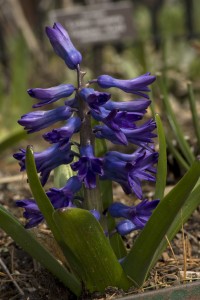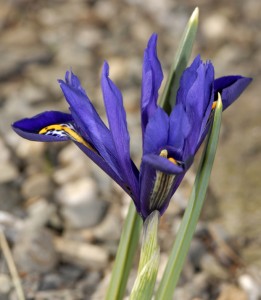Bring on the Bulbs
Posted in Gardening Tips on October 23 2012, by Sonia Uyterhoeven
Sonia Uyterhoeven is the NYBG‘s Gardener for Public Education, and can often be found hosting gardening demonstrations on Saturdays and Sundays.

Next weekend, I will be teaching visitors to the Home Gardening Center how to properly site, plant and protect their bulbs from hungry critters. It is a demonstration that I enjoy giving every year. We examine a number of bulbs, learn all the basics and then find a few nice empty spots around the Garden to plant. It is one of the demonstrations where I like to get hands-on with visitors, encouraging them to jump in and help prepare a nice display for the spring.
Last week, I made the rounds with a few of the curators and gardeners asking them about their favorite bulbs and planting techniques. The first stop I made was to meet with Jody Payne, the curator of the Rock Garden. I asked her for some good recommendations for the homeowner.
Our discussion started with one of my favorite spring blooms for fragrance–hyacinths. Jody recommended the Festival Series as a good choice. Festival Series hyacinths have a more open form than your traditional hyacinth and they are not so prone to flop over once they are in full bloom. Each bulb produces several flower stalks providing a full display. The Festival Series comes in pink, white, and blue, with a delicious fragrance. They create a nice, naturalistic look in the garden.
If you are buying other varieties of hyacinths, Jody’s tip is not to select the largest bulbs. This is counter to general bulb wisdom which dictates that a larger bulb–ergo a greater food storage system–will produce a healthier specimen. Hyacinths are bred these days for the cut flower trade. The larger bulbs will produce massive flowers that make impressive bouquets. In the garden, however, these large flowers tend to topple over as soon as they open. A medium-sized bulb will produce a slightly smaller flower that will be better able to withstand all the perils of weather.

The reality of the situation is that the general consumer doesn’t usually have a choice in bulb size and you just take what you can get. What does matter is the condition of the bulbs that you purchase. Make sure that they are firm and plump. If they are soft, shriveled or have a lot of mildew on them, they will in all likelihood not grow. A little mildew on the bulb is fine (this is common in tulips), but if there is a lot of mildew it is best to throw the bulb out.
For gardeners with shade, Jody recommends early-blooming minor bulbs such as Siberian squill (Scilla siberica) and winter aconite (Eranthis hyemalis). These are some of the first bulbs to emerge from the ground toward the end of the winter. Both species naturalize well in the garden.

One of Jody’s late winter and early springtime favorites are the dwarf irises (Iris reticulata). These irises are ideal for rock gardens and the edge of a border. These little irises are only four inches tall and should be planted en masse. Plant them in swathes of 20 to 50 bulbs. Jody thinks they look like little soldiers marching along, so she plants them in narrow ribbons or strips that march their way through the Rock Garden like a little army.
One of my favorite dwarf irises is Iris ‘Katherine Hodgkins’. It is a cross between a blue and a primrose yellow iris. The result is a pale, greenish-blue iris with yellow and white blotches. It is very beautiful and should be planted in a large mass on its own. Do not plant ‘Katherine Hodgkins’ near a dark blue dwarf iris or it will look washed out. One of Jody’s favorites is Iris ‘Spring Time’–a lovely two-toned blue iris.
Jody combines many of her dwarf irises with small species of tulips such as Tulipa clusiana ‘Peppermint Stick’, which flowers in early to mid spring. By then the irises are finished, but their long, reed-like foliage combines beautifully with the broad foliage and the substantial red and white candy cane flowers of this six- to eight-inch-tall tulip. Join us next week as we continue with this topic by looking at other interesting tulips for the garden.

